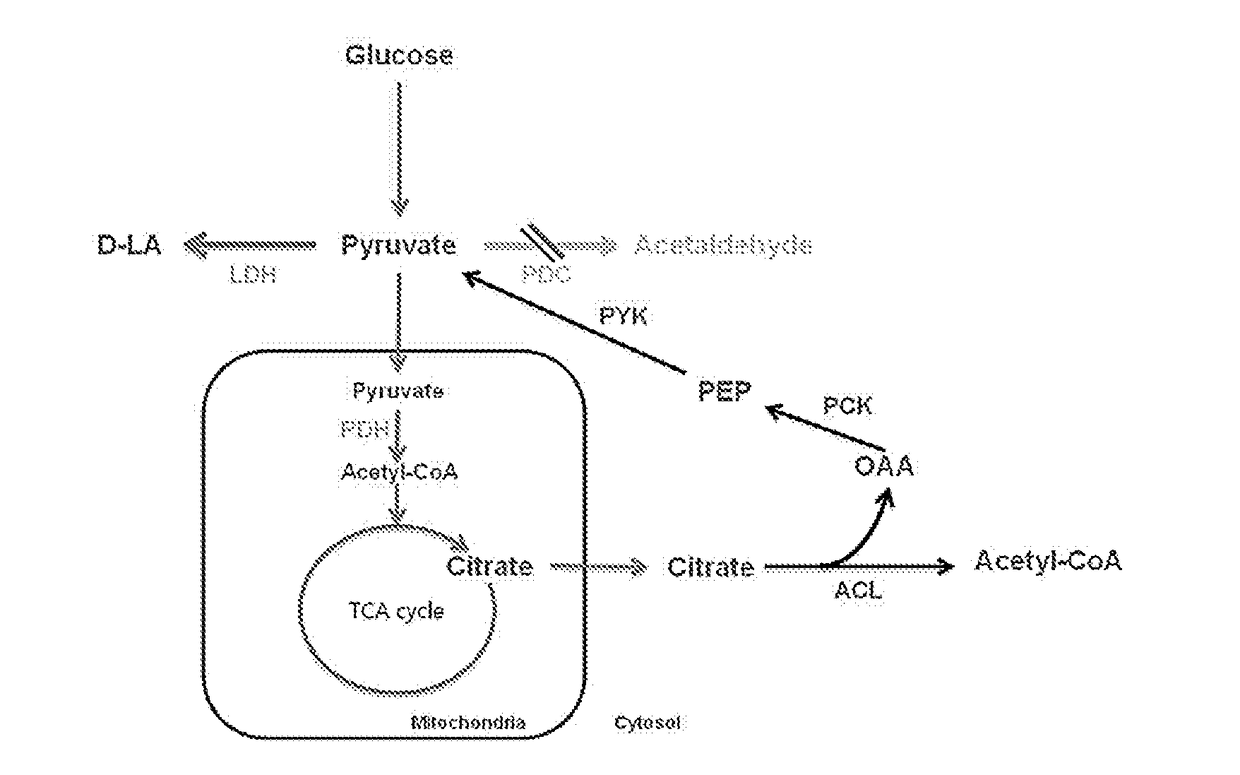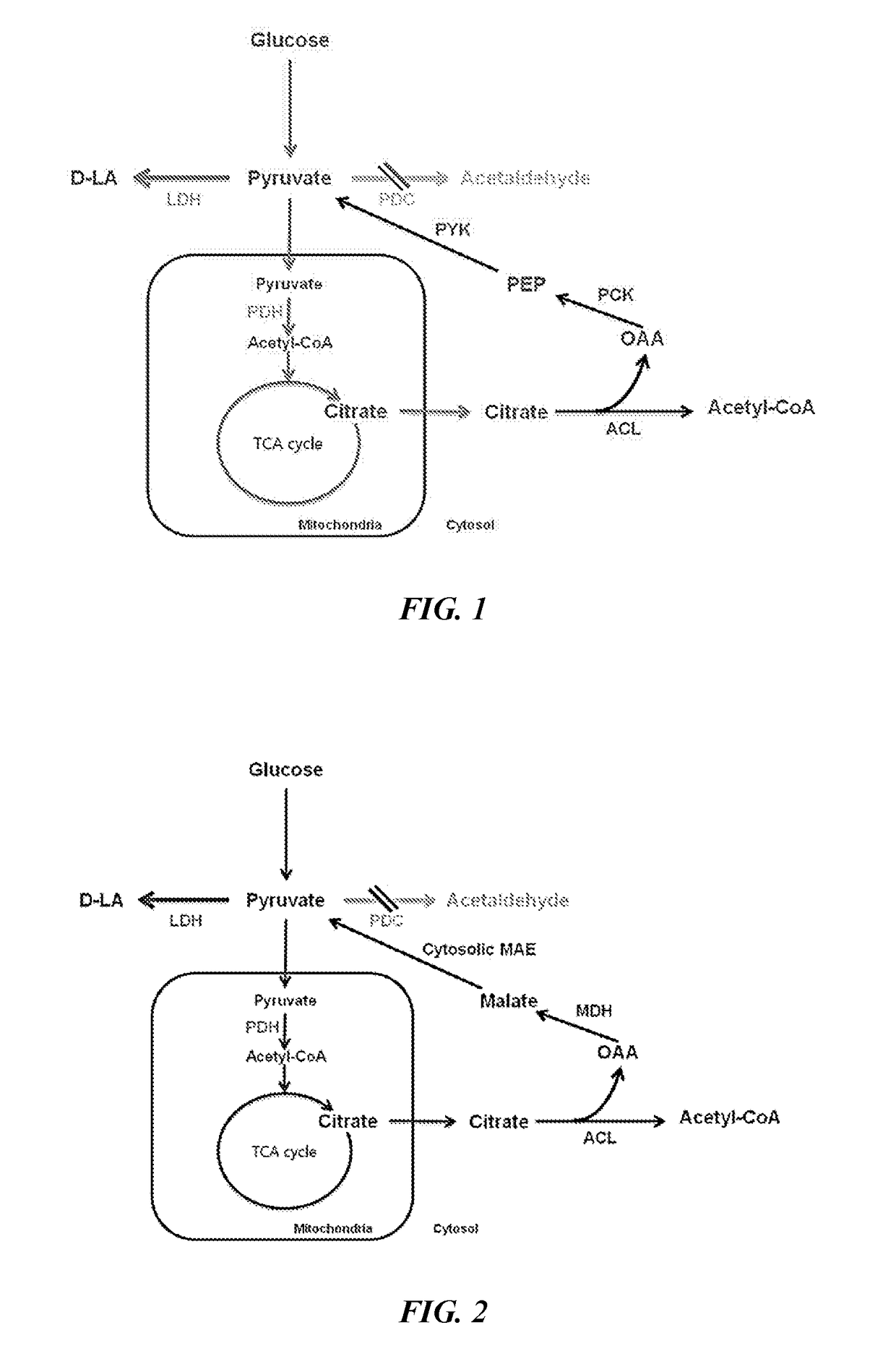Microorganism producing lactic acid and method for producing lactic acid using same
a technology of lactic acid and microorganisms, which is applied in the direction of lyase, transferase, peptide, etc., can solve the problems of reducing productivity, strains cannot be grown smoothly, and it is difficult to produce the desired amount of lactic acid, etc., to achieve excellent lactic acid fermentation yield and productivity, and minimize fermentation. , the effect of enhancing the biosynthetic pathway
- Summary
- Abstract
- Description
- Claims
- Application Information
AI Technical Summary
Benefits of technology
Problems solved by technology
Method used
Image
Examples
example 1
Preparation of Lactic Acid-Producing Strain
[0072]In order to prepare a representative lactic-acid producing strain to be used in the present application, Saccharomyces cerevisiae CEN. PK2-1D, which is a representative yeast strain among the wild-type yeast strains obtained from Euroscarf, were subjected to a series of genetic manipulation.
[0073]Specifically, alcohol dehydrogenase 1 (ADH1) and pyruvate decarboxylase 1 (PDC1) were deleted for minimizing the fermentation of producing the alcohol, whereas for blocking the pathway of lactic acid decomposition, the strain with a deletion in D-lactate dehydrogenase 1 (DLD1) was used as the base strain of the present application.
[0074]DLD1 is not a factor that directly affects the improvement of growth but DLD1, being a dehydrogenase of D-type lactic acid, is known as a major enzyme that converts lactic acid into pyruvate using NAD+. Accordingly, subsequent stains were prepared based on the strain with a deletion of the DLD1 gene, which is ...
example 2
Preparation of Strains with Reduced Titer or Inactivated PDC
[0082]A strain with a reduced titer or inactivation of PDC was prepared by preparing a strain, which had a deletion of PDC5, i.e., a PDC isozyme, in the CC02-0064 strain, which is the base strain prepared in Example 1, and a strain which had deletions of both PDC5 and PDC6 in the CC02-0064 strain.
[0083]Specifically, for the deletion of the gene of a yeast, pWAL100 and pWBR100 plasmids (J. Microbiol. Biotechnol., (2006) 16 (6), 979-982) were used.
[0084]For the deletion of PDC5, PCR was performed using the primers of SEQ ID NO: 11 and SEQ ID NO: 12 and the resultant was cloned into pWAL100 using the restriction enzymes, BamHI and NotI. Additional PCR was performed using the primers of SEQ ID NO: 13 and SEQ ID NO: 14 and the resultant was cloned into pWBR100 using the restriction enzymes, SpeI and NcoI. PCR was performed by denaturation at 95° C. for 5 min, annealing at 53° C. for 1 min, and polymerization at 72° C. for 1 min ...
example 3
Evaluation of Lactic Acid Productivity of Strains with Reduced or Inactivated PDC Activity
[0087]The media used for the evaluation of strains were synthetic complex media (SC). For the preparation of the media, an amino acid dropout mix (Sigma) was mixed to the 0.67% yeast nitrogen base without amino acid, which was used as the base, according to the manufacturer's protocol, and the amino acids not included therein were added as necessary. Leucine was added to a concentration of 380 mg / L, and uracil, tryptophan, and histidine were added to a concentration of 76 mg / L, respectively, and glucose (8%) as a carbon source and 1% CaCO3 as a neutralizing agent were added thereto. The thus-prepared media were used for the evaluation of lactic acid fermentation of yeast strains.
[0088]As the conditions for the evaluation of lactic acid fermentation ability of the strains, the media prepared for the evaluation of lactic acid fermentation were aliquoted in an amount of 25 mL per each flask and in...
PUM
| Property | Measurement | Unit |
|---|---|---|
| Fraction | aaaaa | aaaaa |
| Fraction | aaaaa | aaaaa |
| Fraction | aaaaa | aaaaa |
Abstract
Description
Claims
Application Information
 Login to View More
Login to View More - R&D
- Intellectual Property
- Life Sciences
- Materials
- Tech Scout
- Unparalleled Data Quality
- Higher Quality Content
- 60% Fewer Hallucinations
Browse by: Latest US Patents, China's latest patents, Technical Efficacy Thesaurus, Application Domain, Technology Topic, Popular Technical Reports.
© 2025 PatSnap. All rights reserved.Legal|Privacy policy|Modern Slavery Act Transparency Statement|Sitemap|About US| Contact US: help@patsnap.com


